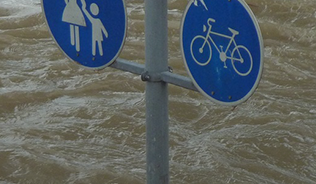environmental SCIENTIST | Planning a route to sustainable transport | March 2022
Natalie Rees examines how behaviours and habits are formed and what it takes to change them.
Travel patterns and habits
Travel patterns are dominated by habit, and our habits and routines are embedded within our everyday lives. Behaviours like driving to work tend to be ingrained habits that are difficult to change, with people questioning their frequent behaviours less as it is these routine ones that we tend not to think about.
So, what does change our habits? Usually, we do. While external factors, such as policy changes or encouragement by celebrities like David Attenborough, can persuade us to alter our behaviour, we tend to modify it in response to changes in our environment and through changes in perception resulting from better education. New behaviours – rather than changed behaviours – can result from increased costs and the benefits of potential savings made. For example, higher energy costs can lead to implementation of energy-saving initiatives. Alternatively, changes could come about because of several interconnected factors such as perception, attitude and the prevalence of behaviours in society. A recent example is the move towards plastic-free living.
The ‘fresh start effect’, a term coined by Dr Katherine Milkman, PhD Professor of Operations, Information and Decisions at the University of Pennsylvania’s Wharton School, describes how disruptive routines can lead to changed behaviours,1 and we have certainly seen disruption over the past two years. Our routines and habits have been changed to the point where we are now forming new ones, such as regularly working from home.
Perception and behaviour patterns
Over 90 per cent of changes in car use are associated with a change in circumstances. Transport for London’s Car Ownership and Use Exploratory Study examined the reasons behind current trends in car ownership and use and explored whether these trends could be expected to continue. The study found that significant change is necessary for people to think about their travel and identified the following key trigger factors:
- Changing job;
- Moving to a new house;
- A change in health (especially among older people);
- A change in family circumstances (especially among younger people);
- Changes to the transport network and cost of travel;
- A desire to improve fitness; and
- A desire to reduce one’s carbon footprint.2
There are of course other key influences on behaviour, which include attitude, perception, cost and capability. For example, the perception that it is unsafe deters people from cycling. In 2020, the national travel attitudes study (NTAS) showed that 66 per cent of adults aged over 18 said that they felt it was too dangerous to cycle on the road, with a higher percentage of women agreeing than men. In contrast to perception, the NTAS showed that a cycling fatality occurred once in every 9 million bike rides, and that there was a 5 per cent risk of injury for every 1,000 hours of cycling. In fact, statistically, cyclists are less likely to be injured or killed than car drivers.3 Changing people’s attitudes through this evidence should create a better perception of the safety of cycling and inspire behaviour change, particularly if people’s attitude is that they would like to give cycling a go.
A report from Sustrans found that 55 per cent of people from ethnic minority groups would like to start cycling. This is not the only group of potential users that were identified in the report: 38 per cent of people at risk of deprivation, 36 per cent of women and 31 per cent of disabled people who do not cycle would like to.4
The OVO bike scheme (formerly nextbike) in Cardiff saw bicycles placed throughout the city and take-up by a range of community users. Therefore, it is reasonable to conclude that bike-share schemes would form a valuable element of any integrated transport network. In Cardiff there were a total of 89,496 members in July 2020 with nearly 115,000 rentals for its 1,000 bikes.
The charity Living Streets believes that it is for those journeys that people could walk where the biggest impact could be made. One such journey is the school run. Just one generation ago, 70 per cent of British children walked to school; now fewer than half do, despite studies showing that children who walk or bike to school tend to be more focused and less likely to be overweight.5
In 2020, 25 per cent of trips were for distances under 1 mile and 80 per cent of these trips were done on foot. However, as distance increases to 5 miles, the number of people walking decreases to 25 per cent, the number of people cycling is around 5 per cent and the number of car users is now 65 per cent.6 How we choose to travel to the office, or even pop to the shops, is becoming one of the biggest day-to-day climate decisions we face. The Transport and Environment Statistics Annual Report states that in the UK 55 per cent of transport emissions come from cars7 and that as well as releasing a lot of carbon into the atmosphere, pollution from cars dramatically decreases the quality of the air we breathe.
Learning from others
For the last 100 years, city transport strategies have prioritised cars.8 Today, the cities creating successful transport strategies are prioritising the movement of people, giving residents and visitors a wider variety of attractive transport options.
A 2013 survey by the European Commission found that Europeans believe the two best measures for improving urban transport are lower prices and better public transport.9 In March 2020, Luxembourg made all public transport free, and Paris, France, has free travel for under-18s. Surprisingly, where free public transport has been introduced, only a small number of car users make the switch; those making use of free public transport are the active travellers.10
There is also evidence from studies undertaken in Tallinn, Estonia, where free public transport resulted in a 10 per cent modal shift from cars. However, this was accompanied by a change from walking to public transport, with a 40 per cent decrease in walking trips.11
Nevertheless, free public transport should not be overlooked. It could considerably reduce the number of private vehicle journeys if the under-18s can access public transport, and free public transport could improve access to jobs, education and other services for ethnic minority and low-income groups.
Free transport alone, however, may need to be used in conjunction with deterrents against car use to be most effective. In Oslo, Norway, and Seville, Spain, measures have been introduced to make parking more difficult by turning parking spaces into cycle lanes or pedestrian areas, or by increasing parking fees. As well as making car use less attractive, a move away from private cars will require convenient and affordable alternatives that are easy to access for travellers.
The role of placemaking
Just as important as providing suitable transport options is the creation of place. Placemaking refers to the strengthening of connections between people and places. It requires people-centric planning and participation by communities to create places that meet their aspirations. Where placemaking principles are used, well-designed and safe walking, cycling and public transport routes are prioritised, and a good variety of modes lessen people’s dependence on cars. The local community is involved in the development process, and proposals are shaped to meet their needs. This helps to create pride in the community.
With a pledge to become carbon neutral by 2025 and with awards for the Most Sustainable City in the World and the Greenest City in Europe, Copenhagen, Denmark, leads the world in sustainability. It is not only its exceptional transport networks that have won it these accolades, but also access to urban farming and moveable housing. Off the designated cycle lanes, Copenhagen’s residential streets are home to traffic-calming measures including narrow lanes and textured road surfaces, so cyclists and motorists can share the space.12
Similarly, the 20-minute neighbourhood (also referred to as the 15-minute city), where communities can conveniently access the facilities and services they need could reduce car dependency. A 1-mile journey on foot takes about 20 minutes. Yet, as we have moved away from traditional town centres to out-of-town shopping centres and superschools and as housing has been built without suitable travel routes, the journey from home to the services, green spaces and jobs we need has become longer and more difficult. Poor planning has meant that some communities are so isolated that access to even small local shops requires a car journey.
Some journeys will remain difficult to undertake via public transport, by bike or on foot. For those who live in very rural areas and for carers of elderly people or people with disabilities, a car may be essential.
By creating better communities, we can make it easier for people to travel sustainably. Research undertaken by Sustrans shows that people are generally happy to walk for 20 minutes to get to and from the places they need to go.13 Habitual behaviour can take a long time to change, and without the right support and reinforcement it is easy to slip back into old habits. The key to enabling transformation is to catch people at that moment of change – when they buy a new house or start a new job – and the balance and measures needs to be right. Otherwise, this can push behaviour down the opposite path, making change difficult.
Transport planning for the future
Reaching the 2050 net zero target would involve change at a pace and scale that requires new systems that make it easy to access more sustainable travel options and enable earlier formation of new habits. Subtle nudges may change attitudes and lead to new behaviours,14 but more robust policies and actions aimed at directly changing habits are required, such as increasing vehicle tax, raising fuel prices or introducing road pricing – tolls, congestion charging or charging for peak time travel, which is utilised in Singapore to manage road congestion, are some examples.
Co-benefits are also important. Reducing the number of short trips made by car cannot only reduce carbon emissions but can also improve air quality, help people improve their fitness, and reduce levels of obesity. It can also inspire young people to continue good habits into adult life. Travelling more actively could also improve prosperity and equality: active travel is a low or no cost option, and money saved could be invested in local communities or improve conditions for people living in poverty. To enable this behaviour, safe active travel routes and accessible, reliable public transport need to exist.
Creating an integrated transport system and increasing the availability of services – so that people can easily change from bus or train to cycling or walking or utilise multiple modes of travel with one app – will be key to enabling effective behaviour change. Ultimately, it is about making it as easy as getting your keys and getting in the car. Mobility as a service (MaaS) is a term used to describe digital transport service platforms that enable users to access, pay for and get real-time information on a range of public and private transport options. MaaS envisages users buying transport services as packages based on their needs instead of buying the means of transport. The emergence and implementation of MaaS will be exciting to watch and be a part of for those who work in and use public transport and active travel.
Natalie Rees BA, MSc, MIEnvSc, CEnv is the Sustainable Development Manager at Transport for Wales (TfW). She works within the organisation and with TfW’s partners and stakeholders to embed the Wellbeing of Future Generations (Wales) Act 2015. Natalie has over 18 years’ cross-sector experience in the field of sustainable development and climate change, is a keen active traveller and an advocate for sustainable travel. Natalie is the vice-chair of Groundwork Wales and sits on the board of directors at Fairtrade Wales.
References
- Dai, H., Milkman, K. and Riis, J. (2014) The fresh start effect: temporal landmarks motivate aspirational behavior. Management Science, 60 (10). https://doi.org/10.1287/mnsc.2014.1901 (Accessed: 7 March 2022).
- Transport for London. (2008) Car Ownership and Use Exploratory Study. https://content.tfl.gov.uk/technical-note-13-what-are-themotivations-for-owning-a-car.pdf (Accessed: 25 February 2022).
- Department for Transport. (2020) National travel attitudes study: wave 3 https://www.gov.uk/government/statistics/national-travelattitudes-study-wave-3 (Accessed: 25 February 2022).
- Burns. T., Oram, M-Y. and Claris, S. (2020) Cycling for Everyone: A Guide for Inclusive Cycling in Cities and Towns. Arup and Sustrans. https://www.sustrans.org.uk/media/7377/cycling_for_everyonesustrans-arup.pdf (Accessed: 25 February 2022).
- Timperley, J. (2020) How our daily travel harms the planet. BBC Future. https://www.bbc.com/future/article/20200317-climatechange-cut-carbon-emissions-from-your-commute (Accessed: 25 February 2022).
- Department for Transport. (2021) National travel survey: 2020. https://www.gov.uk/government/statistics/nationaltravel-survey-2020/national-travel-survey-2020 (Accessed: 25 February 2022).
- Department for Transport. (2021) Transport and Environmental Statistics 2021 Annual Report. https://assets.publishing.service. gov.uk/government/uploads/system/uploads/attachment_data/ file/984685/transport-and-environment-statistics-2021.pdf (Accessed: 25 February 2022)
- C40 Cities Climate Leadership Group and C40 Knowledge Hub. (2021) How to drive a modal shift from private vehicles to public transport, walking and cycling. https://www.c40knowledgehub. org/s/article/How-to-drive-a-modal-shift-from-private-vehicle-useto-public-transport-walking-and-cycling?language=en_US (Accessed: 25 February 2022).
- Cats, O., Susilo, Y.O. and Reimal, T. (2017) The prospects of fare-free public transport: evidence from Tallinn. Transportation, 44, 1083–1104. https://doi.org/10.1007/s11116-016-9695-5 (Accessed: 25 February 2022).
- Thøgersen, J. and Møller, B. (2008) Breaking car use habits: the effectiveness of a free one-month travelcard. Transportation, 35, 329–345. https://doi.org/10.1007/s11116-008-9160-1 (Accessed: 25 February 2022).
- Cats, O., Susilo, Y.O. and Reimal, T. (2017) The prospects of fare-free public transport: evidence from Tallinn. Transportation, 44, 1083–1104. https://doi.org/10.1007/s11116-016-9695-5 (Accessed: 25 February 2022).
- McCrory, S. (2021) From ski slopes to slow fashion: how Copenhagen became the greenest city in Europe. TimeOut. https://www. timeout.com/copenhagen/things-to-do/how-copenhagen-becamethe-greenest-city-in-europe (Accessed: 25 February 2022).
- Sustrans. (2020) What is a 20-minute neighbourhood? https://www. sustrans.org.uk/our-blog/get-active/2020/in-your-community/whatis-a-20-minute-neighbourhood (Accessed: 25 February 2022).
- McCarthy, L., Delbosc, A., Kroesen, M. and de Haas, M. (2021) Travel attitudes or behaviours: which one changes when they conflict? Transportation. https://doi.org/10.1007/s11116-021-10236-x (Accessed: 25 February 2022)





